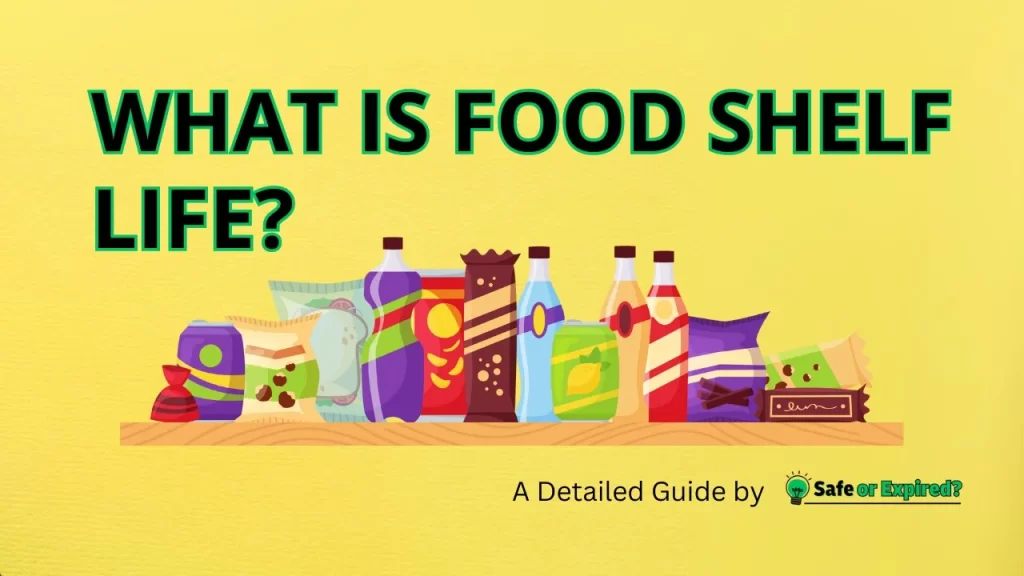Have you ever looked at a food item and wondered, “How long can this last before it goes bad?” That’s where the concept of food shelf life comes into play. It’s a crucial piece of information that tells us how long food maintains its quality and safety before it goes bad.
Here, you will learn all about shelf life along with examples, factors affecting it, and how you can maximize life by doing ten simple things.
Let’s begin!
What Is Food Shelf Life?
Food shelf life is the period during which food retains its safety and nutritional value, assuming it is stored under appropriate conditions. Unlike expiration dates, shelf life is not an exact cut-off point for food safety but rather a guideline for food quality.
Knowing about shelf life is crucial for several reasons. Firstly, it will help you make informed decisions about food storage, thus reducing waste. Importantly, understanding and adhering to shelf life recommendations is vital for preventing foodborne illnesses.

According to the CDC, millions of Americans get sick from foodborne diseases each year, highlighting the need for careful attention to food storage and consumption timings. The WHO also emphasizes the global importance of food safety, linking it to health security and reduced disease transmission.
To illustrate the concept of shelf life, consider the following table based on guidelines from FoodSafety.gov, which provides a snapshot of how long certain foods maintain quality under ideal storage conditions:
| Food Type | Refrigerator (40°F or below) | Freezer (0°F or below) |
| Salads (Egg, chicken, ham, tuna) | 3 to 4 days | Does not freeze well |
| Hot dogs (Opened package) | 1 week | 1 to 2 months |
| Bacon | One week | Do not freeze in a shell |
| Hamburger, ground meats | 1 to 2 days | 3 to 4 months |
| Fresh poultry (Chicken or turkey, whole) | 1 to 2 days | One month |
| Canned evaporated milk | 12 months | 18 months |
| Eggs (Raw, in shell) | 3 to 5 weeks | One week |
Types of Food and Their Shelf Life
Food shelf life varies widely across different types. Perishable foods like dairy and meat last days to weeks and require refrigeration. Semi-perishable items, such as potatoes and onions, can last months in proper condition. Non-perishable foods, including canned goods and dry grains, have the longest shelf life, often lasting years.
Perishable Foods
Perishable foods are items that spoil, decay, or become unsafe to eat if they are not kept at the right temperature for a certain amount of time. These foods include things like fruits, vegetables, meat, poultry, fish, dairy products, and prepared meals.
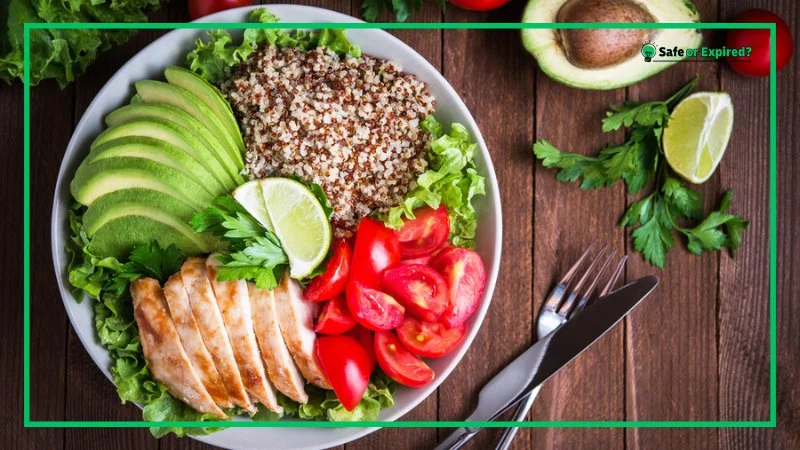
Because these foods can go bad quickly, they need to be refrigerated or frozen to keep them fresh and safe to eat. Perishable foods are different from shelf-stable products, like canned goods or dry pasta, which can be stored at room temperature for a longer time.
Here’s a table of popular Perishable foods and their shelf life.
| Food Type | Refrigerator Shelf Life |
| Milk | 7 days |
| Yogurt | 2-3 weeks |
| Fresh chicken or turkey | 1-2 days |
| Fresh beef, veal, lamb, pork | 3-5 days |
| Fresh fish | 1-2 days |
| Leafy vegetables | 3-7 days |
| Soft cheeses (Brie, Ricotta) | 1-2 weeks |
| Eggs | 3-5 weeks |
Non-Perishable Foods
Non-perishable foods are items that can be stored at room temperature. You don’t also have to worry about eating them quickly. They can stay “eatable” for a long time without spoiling or decaying. These foods don’t need to be refrigerated or frozen to stay fresh.
Examples include canned goods, dried fruits, grains, nuts, powdered milk, and packaged snacks. Non-perishable foods are great for stocking up because they last a long time, making them ideal for emergencies or long-term storage.
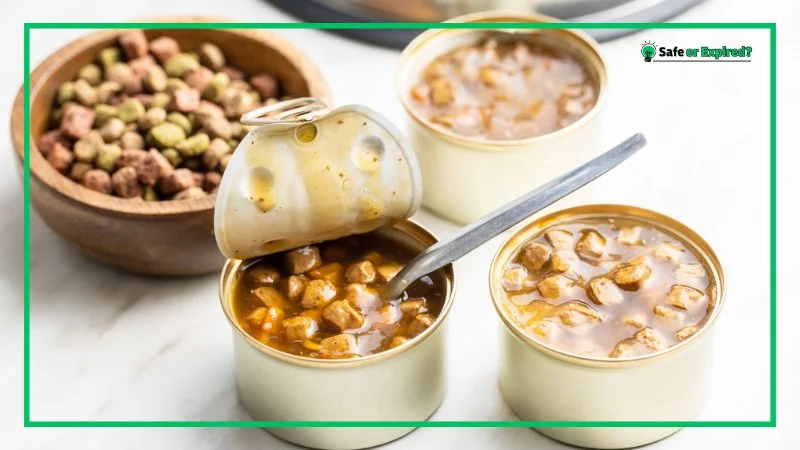
Here’s a table of popular non-perishable foods and their shelf life:
| Food Type | Shelf Life |
| Canned vegetables | Up to 5 years |
| Dried beans | Up to 1-2 years |
| Rice | Up to 5 years |
| Pasta | Up to 2 years |
| Canned tuna | 2-5 years |
| Dried lentils | Up to 1 year |
| Canned fruits | 1-2 years |
| Powdered milk | 6 months to 1 year |
Semi-Perishable Foods
Semi-perishable foods are items that have a longer shelf life than perishable foods but will eventually spoil or degrade in quality if not stored properly. These foods do not spoil as quickly as perishable items like meat or dairy but won’t last indefinitely at room temperature like non-perishable foods.
Examples of semi-perishable foods include potatoes, onions, apples, and certain types of bread.

While these items can be kept at room temperature for a relatively extended period, they will last even longer when stored in dry conditions or refrigerated.
Here’s a table of popular semi-perishable foods and their shelf life:
| Food Type | Refrigerator Shelf Life |
| Hard cheeses | 3-6 months |
| Semi-hard cheeses | 1-6 months |
| Eggs | 3-5 weeks |
| Butter | 1-3 months |
| Opened jam | Six months |
| Nuts | 6 months |
| Flour | 6-8 months |
| Sugar | Indefinite |
Note that Storage conditions play a critical role in the shelf life of all food types. Proper storage can help preserve food quality and extend shelf life, while poor storage conditions can accelerate spoilage.
For perishable foods, refrigeration is key to slowing bacterial growth. For non-perishables, cool, dry conditions prevent degradation. Semi-perishables benefit from refrigeration or cool, dry storage, depending on the specific item. In addition, many other factors also affect the shelf life and it’s now time to discuss what they are.
Which Factors Affect the Shelf Life of Food?
There are lots of factors that affect the shelf life of food: temperature, moisture, and exposure to air are key. Proper storage conditions, like refrigeration or airtight containers, can extend it. Additionally, food’s natural composition, processing methods, and packaging play significant roles in determining how long it remains fresh and safe to consume.
Microbial Growth
Microorganisms such as bacteria, yeasts, etc., are usually present in foods. However, their growth can be both beneficial (in fermentation) and detrimental (causing spoilage and diseases).
According to the Predictive Modeling of Microbial Behavior in Food report, Microbial growth depends on several factors, including nutrient availability, pH level, and especially the presence of water and suitable temperatures. Managing these factors helps control microbial activity, preserving food quality and safety.
Predictive microbiology plays a crucial role in estimating the shelf life of food items. It uses mathematical models and computer-based methods to predict how microorganisms in food will grow, survive, and act. This helps in making well-informed choices about food safety, quality, and longevity. Emphasizing the need to understand microbial behavior, predictive microbiology aims to stop food from spoiling and keep consumers safe.
Temperature
Temperature is one of the biggest reasons behind spoilage. Most microorganisms thrive at temperatures between 42°F and 142°F (4°C and 60°C), a range known as the “danger zone.”
Quality and Shelf-Life Modeling of Chilled and Frozen Food in Foods journal highlights the importance of temperature in slowing down the reactions that promote food spoilage and limit shelf life. Refrigeration (below 40°F) significantly slows down microbial growth, while freezing (below 0°F) can halt it all together for most food items.
Similarly, a study in the Foods journal looked at what happens to frozen fish when you keep it at the same or changing temperatures. They found out that the colder you keep fish, the longer it stays good. But, if the temperature goes up and down, like in some freezers, it can make the fish go bad faster. This study helps us understand how to keep frozen fish fresh for a longer time.
Conversely, cooking food at high temperatures (above 140°F) can kill pathogens, making the food safe to consume.
Humidity and Moisture Content
Humidity and moisture content directly impact food’s susceptibility to microbial growth. According to a study published in the Scientific World Journal, high-humidity environments can lead to increased moisture content in foods, providing an ideal breeding ground for mold and bacteria.
This is particularly crucial for dry goods, which can absorb moisture from the air. Effective packaging that controls moisture exchange and storing foods in conditions with appropriate humidity levels are key strategies to prevent spoilage and extend shelf life.
Oxygen Exposure
Oxygen exposure is a double-edged sword in food storage. While essential for life, oxygen can significantly accelerate the spoilage process in food. Food Chemistry Volume 94 has explained it in detail. According to it, this happens through oxidation, a chemical reaction where oxygen interacts with certain components in food, such as fats and vitamins, leading to rancidity, color changes, and nutrient loss.
Similarly, a comprehensive report on the TRF Food Shelf also explains how oxygen can degrade a food’s quality. Note that aerobic bacteria thrive in the presence of oxygen. This bacteria can lead to spoilage and decomposition, making effective packaging strategies crucial to limit oxygen exposure and extend shelf life.
Light Exposure
According to Advances in Food and Nutrition Research, 2021, light exposure (particularly UV light) can detrimentally affect food quality and shelf life. Light can break down photosensitive nutrients like vitamins B and C, leading to nutritional degradation. It also causes fats to oxidize, producing off-flavors and odors.
Furthermore, light can trigger photochemical reactions in certain foods, affecting their color and taste. Packaging solutions that block or filter light, such as colored glass or opaque materials, are important in protecting light-sensitive products.
pH Levels
According to the Journal of Cereal Science, Volume 103, the pH level of food is another critical factor that influences microbial growth. Most pathogens and spoilage microorganisms prefer neutral to slightly acidic conditions and are inhibited or killed in highly acidic environments (low pH). Foods with naturally low pH, like citrus fruits and fermented products, generally have longer shelf lives due to this natural protection against microbes.
Conversely, adjusting the pH of food through methods like fermentation or the addition of acids can be an effective preservation strategy, inhibiting unwanted microbial growth and spoilage.
Packaging
Think of packaging as a superhero cape for food. It protects food from enemies like air, moisture, and germs that can make it go bad. Some packages suck all the air out to keep food fresh, while others change the air inside to slow down spoilage. And it’s not just about keeping the bad stuff out.
Food packaging interaction is a complex process involving the transfer of packaging material to the food or vice versa, impacting food quality. Various materials, like metal or glass, offer lower mass transfer rates compared to plastics, affecting the food’s quality and integrity differently.
The right packaging can also stop food from losing its taste or nutrients. So, next time you see a food item wrapped up, remember, it’s doing a lot more than just looking pretty.
A Harvard T.H. Chan School of Public Health study highlights “smart” packaging made from biodegradable biopolymers and natural antimicrobials like thyme oil and citric acid. This packaging is designed to ward off harmful bacteria and spoilage microorganisms, extending the shelf life of foods like strawberries significantly compared to traditional plastic packaging.
Chemical Composition and Structure
What’s inside your food matters a lot. Foods with lots of fats can go bad quickly because fats don’t like air too much. But, if your food is sour like a lemon, it’s got a natural shield against germs.
Water is another tricky one. Too much water makes it easy for germs to grow, but dry foods like rice and pasta can hang around for a long time without any trouble. It’s all about the balance of what’s inside that keeps food good to eat.
Preservatives
According to the The section of Foods journal dedicated to Food Packaging and Preservation, Preservatives are like food’s best friends that help it stay young and fresh. Some are natural buddies, like salt, sugar, and vinegar, which have been keeping food safe for centuries. They work by making it tough for germs to grow.
Then there are the modern helpers, special ingredients added to food to target the germs that cause spoilage. Whether old school or new age, preservatives are all about keeping your food safe for longer.
Processing Techniques
Before food even makes it to the packaging stage, it often goes through various processing techniques that can either make it last longer or shorten its shelf life. This is explained in detail in Food Safety and Quality-Based Shelf Life of Perishable Foods pp 91–103. Don’t worry; I’ve made the summary.
- Freezing is a cool way to keep food fresh for months or even years by putting bacteria into a deep sleep.
- Canning heats food up to knock out bacteria and seals it in airtight containers, making it shelf-stable for a long time.
- Drying food pulls out moisture, leaving bacteria high and dry with nothing to grow on. Each of these methods tweaks the food’s natural state to give it a longer shelf life.
In Int J Food Microbiol, each of these techniques minimizes cell damage and ensures the retention of food nutrients,
Storage Conditions
Where and how you store your food can make a big difference in how long it stays fresh. Cooler temperatures slow down bacteria’s dance party, so refrigerating or freezing food can keep it safe for longer. On the flip side, storing food in warm or humid places invites bacteria to a feast, speeding up spoilage.
Light and air can also join the party, affecting the flavor, color, and nutritional value of food. So, keeping food in the right conditions is like giving it a comfy home where it can stay fresh for as long as possible.
Ethylene Production
Now, let’s talk about an invisible factor: ethylene. A study in Journal of Agricultural and Food Chemistry states that ethylene is like the plant world’s signal to ripen up. Fruits and vegetables produce it, and it can speed up ripening and, eventually, spoiling. That’s why keeping ethylene-producing foods away from other produce can prevent a premature spoilage spree.
Think of ethylene as a secret message between fruits and veggies, telling them it’s time to ripen up. Managing this ethylene communication can help keep your produce fresher for longer.
How to Determine the Shelf Life of Food?
To determine the shelf life of food, check packaging dates and follow storage instructions. Use sensory cues: smell, texture, and color changes indicate spoilage. For homemade or unpackaged items, consult food safety guides. Remember, understanding the type of food and its storage environment is crucial for accurate assessment.
Fresh Fruits and Vegetables
Fresh fruits and vegetables are often the trickiest to gauge because their shelf life can vary widely based on type, ripeness, and storage conditions. Visual inspection is your first tool—look for signs of spoilage like mold, soft spots, or an off smell. For many fruits, like bananas and avocados, color changes can indicate ripeness and impending over-ripeness.
Ethylene sensitivity plays a role, too; some fruits, like apples, produce ethylene gas, which can accelerate ripening and spoilage in ethylene-sensitive produce stored nearby. Separating ethylene-producing from ethylene-sensitive items can help extend freshness.
Meat, Poultry, and Seafood
For meat, poultry, and seafood, sell-by and use-by dates provided by manufacturers are key indicators. However, these foods can spoil before the use-by date if not stored properly. A meat thermometer can ensure meats are cooked to safe temperatures, indirectly indicating freshness, as fresher meats usually require standard cooking times.
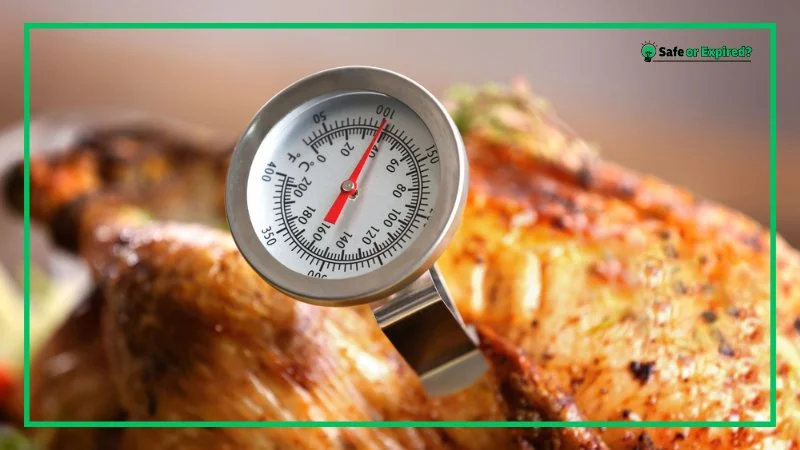
Smell and texture tests also apply; any off odors or slimy textures on the surface are clear indicators that the food has gone bad and should not be consumed.
Dairy Products
Dairy products, including milk, cheese, and yogurt, often come with use-by dates, which should be adhered to. However, the shelf life can sometimes be extended beyond these dates if the products are stored correctly.
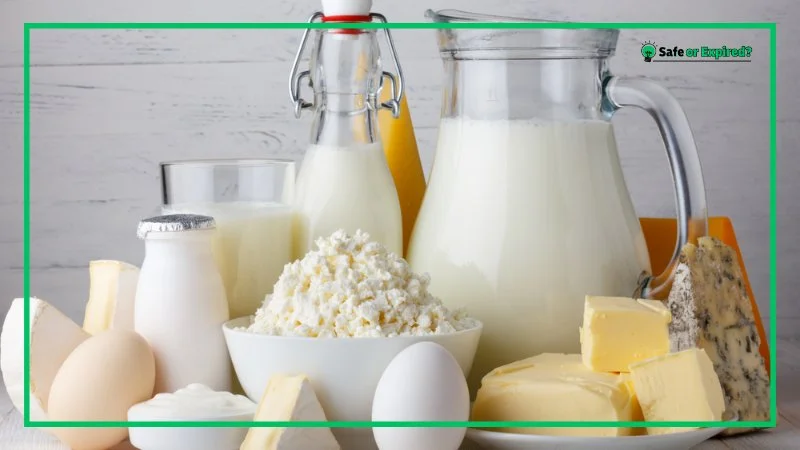
For instance, cheese can last longer if it’s stored at the right humidity and temperature. A smell test is reliable for milk—a sour smell equals spoilage.
Canned and Packaged Foods
Canned and packaged foods are generally more straightforward, thanks to expiration dates. Yet, the integrity of the packaging is also a factor; any dents, rust, or swelling in cans can indicate a compromised product, regardless of the date stamped on it.
For dry packaged goods like pasta or rice, keeping them in a cool, dry spot helps ensure they last as long as possible.
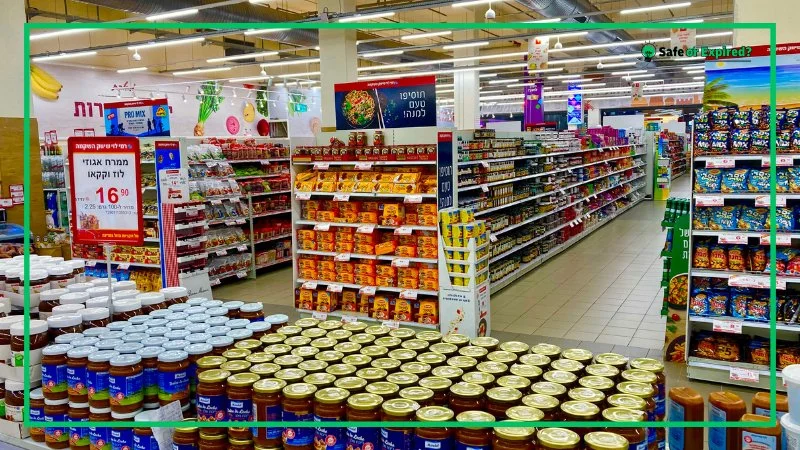
Bread and Baked Goods
Bread and baked goods often have a best-before date, but they can last longer if stored properly. Bread keeps fresh longer when stored in a dry place and can even be frozen to extend its shelf life. Here’s what fresh pieces of break look like:
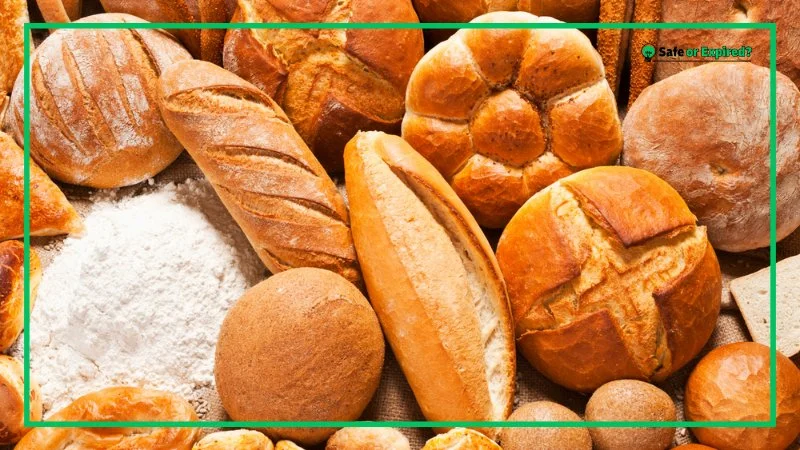
Mold growth is a clear sign that bread has gone bad. For baked goods with higher moisture content, like muffins or cakes, refrigeration can help preserve freshness for a few days longer.
Freezer Foods
The freezer can be a time capsule for food, significantly extending the shelf life of many products (from fruits to prepared meals). However, freezer burn, indicated by ice crystals and desiccation, can affect taste and texture, though the food remains safe to eat.

A general rule is that if it’s been in the freezer for over a year (depending on the item), it’s probably lost a significant amount of its original quality.
Utilizing a Shelf Life Calculator: A Tool for Safety and Efficiency
A shelf-life calculator is a simple online tool or app. You tell it what food you have, how you’re keeping it (like in the fridge or pantry), and sometimes when you bought it. Then, it gives you a good guess on how long that food will stay fresh.
It uses a lot of info from food experts to make sure the advice it gives is safe and helps you waste less food. The FoodKeeper App is a popular choice. This app is made with help from the USDA (a big food safety group in the U.S.) and gives great tips on keeping over 400 types of food and drinks fresh.
How to Maximize Shelf Life? Tips and Tricks
Maximizing food shelf life involves proper storage: refrigerate perishables promptly, keep dry goods in airtight containers, and freeze excess. Understanding and controlling temperature and humidity levels are crucial. Additionally, separating foods to prevent cross-contamination and using vacuum sealing for freezer storage can significantly extend the freshness and safety of food items.
Store Properly
According to Frontiers, knowing where and how to store your food is key. Keep fruits and vegetables in the fridge, except for those that do better at room temperature, like bananas and tomatoes. For your pantry items, make sure they’re in a cool, dry spot.
Here’s a simple table listing various foods and the best places to store them for freshness.
| Food | Best Place to Store |
| Apples | Cool, dry place |
| Bread | Room temperature, avoid fridge |
| Eggs | Refrigerator |
| Potatoes | Cool, dark, and dry place |
| Tomatoes | Room temperature, avoid fridge |
| Cheese | Cool, dry place in an airtight container |
| Nuts | Room temperature, in an airtight container |
| Chocolate | Cool, dry place |
| Coffee Beans | Airtight container in a cool, dark place |
| Honey | Room temperature, in airtight container |
Use Airtight Containers
Air can be an enemy of food freshness. That is why whenever you read any food safety guidelines, you will read the suggestion of using airtight containers for items like cereal, flour, and leftovers. The reason? Well, they can keep them fresher longer. Plus, it helps keep bugs and moisture out.
If you’re interested, check out this detailed guide on Food Safety Guidelines. It will surely help you do safe cooking.
Understand Your Fridge
Different parts of your fridge have different temperatures. Keep your dairy products, like milk and cheese, in the colder parts and less perishable items, like condiments, in the door.
Freeze Extra Portions
You can also freeze extra portions of meals to increase their shelf life. As a matter of fact, you can do this with almost every food (bread, and even fruits and vegetables). Just make sure they’re wrapped well to avoid freezer burn.
Keep It Dry
We all know that moisture is the reason behind mold and bacteria growth. So, keep foods like bread and cheese in dry conditions. If you see condensation in containers or bags, it might be a sign to eat that food soon or find a drier storage method.
Rotate Your Stock
Use the “first in, first out” rule. When you buy new groceries, move the older items to the front so you use them first. This helps ensure food doesn’t get forgotten and go bad.
Check Seals and Lids
Make sure the seals on your fridge and freezer doors are tight, and the lids on your food storage containers are secure. This helps keep air out and maintains the right moisture levels.
Use Ethylene Absorbers
Some fruits and veggies produce ethylene gas, which can speed up ripening. Ethylene absorbers are products designed to remove ethylene gas from the environment around perishable goods like fruits and vegetables. You can buy ethylene absorbers for your fruit bowl or fridge to help slow down this process.
Vacuum Seal
If you have a vacuum sealer, use it for meats, cheeses, and other perishables. Removing the air extends their shelf life significantly, especially in the freezer.
Stay Clean
Regularly clean your fridge, freezer, and pantry. Spills and crumbs can attract pests and lead to mold. A clean storage space means longer-lasting food.
That’s all the tips.
Conclusion
In our exploration of food shelf life, we’ve uncovered several critical insights:
- Understanding expiration dates helps consumers make informed decisions about food safety.
- Proper storage techniques/practices can significantly extend the shelf life of many foods.
- Knowing when to throw out food is crucial for preventing foodborne illnesses.
Armed with these tips, you’re all set to reduce waste and enjoy your food at its best. Keeping an eye on food shelf life isn’t just smart—it’s a step towards less waste and more delicious meals. Here’s to fresh food and happy eating!

